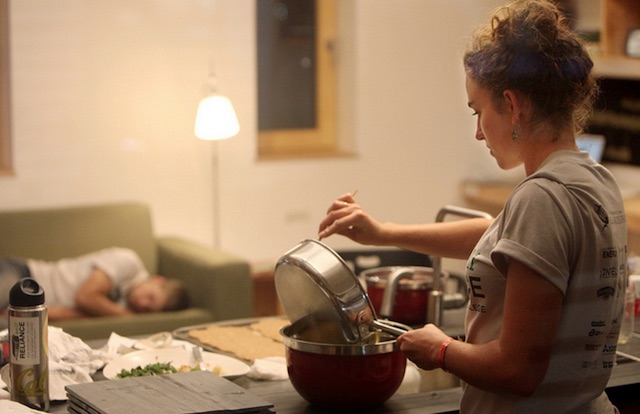Often, the most difficult part of missing anyone—be it a family member, friend, or lover—is how raw and empty it feels.
It’s like probing a sore tooth; we know it will ache, and yet we keep allowing our thoughts to turn to that person. We’ll hit play on our memories of the relationship, slowing down the parts where we feel we may have made a misstep or when perhaps we overlooked a glaring red flag.
I’ve struggled with moving on so many times over the years. From friendships to my marriage to dating relationships, it has been difficult at times to find a way to move past a sense of loss for those who are no longer a part of our lives.
Sometimes, I wonder what the recipe is for moving on.
Yes, I think in recipes from time to time. I enjoy cooking and baking. I love the sensory experience of it, and I find that it often calms me. Whether I’m baking bread or making a batch of cookies or preparing a dinner that my toddlers will likely reject rather than eat, I do spend time thinking about food and preparing it. And I’ve found there are typically two types of cooks:
The first is the one who requires an exact recipe to create something wonderful in the kitchen. This cook wants to know how much to measure of what, without instructions that include a “dash” of this or that. This cook prefers getting it exactly right so that the dish can be recreated exactly as the recipe writer intended.
The second type of cook enjoys the scent, color, and texture of the ingredients he or she lines up for a dish. This cook enjoys playing with measurements and taking some risk in the kitchen. For this type of person, it enriches the sensory experience that is cooking. This cook can add “to taste” and not worry too much that the results won’t come out exactly as someone else may have intended them. This second type of cook is concerned only that the recipe comes out as he or she intended.
(There may be a third type of cook who enjoys utilizing the microwave and delivery to prepare a meal. This cook wants a quick fix at the end of a long day and simple nourishment to fill a need without too much complexity. This cook values his or her time and doesn’t want or choose to meal plan or obsess over recipes at all. Dining out is a special pleasure for this cook, and his or her favorite apron is the one he or she never has to wear. Just pay the delivery man and pass the wine, please and thank you—no judgments here.)
If we stop looking for an exact recipe, if you’ll permit the analogy, of how to move on, perhaps we’ll be able to find what works for us.
Maybe what we really need is to find the right combination of ingredients that will allow us to make the transition. For the precise cook, this may be quite difficult. However, for the cook who can add “to taste,” finding the right recipe through trial and error will be quite a bit easier. For the cook who prefers to save time, this may also offer a challenge, as the timeline for moving on can vary and is impossible to rush.
Serving size: 1
Cook Time: Varies
Ingredients: Wide Array of Emotions
Directions:
First, we must center ourselves with a few deep breaths.
Next, we may want to start with a cup or two of gratitude for having had the opportunity to connect with another soul, no matter how that relationship ended. We can also add in gratitude for the memories that we will choose to cherish. The amount of gratitude may vary, of course, depending on the type of relationship and how it ended. I have a few moments from a relationship that ended earlier in the year that I treasure. I felt beautiful and special and somehow powerful inside of those moments, and I can be grateful to have them.
Then we may need to acknowledge the grief and regret that may exist at the loss of that relationship. Add a dash of tears or a sleepless night or two into the mix. Feel it, and add it in. This may take time. This part cannot be rushed, and we cannot avoid the feelings or deny them if we want to truly move on.
Next, in many cases we’ll want to add in a nice, healthy dose of anger. I know that in my own life I have had to add in anger when dishonesty has been a major factor in a relationship’s end. This anger may come with a tiny teaspoon of bitterness, but not too much because it does not serve us or add to the taste.
We won’t deny that the recipe might need a pinch of attraction to someone else or the distraction of a new hobby. Maybe a little of both. It never hurts to have something or someone who helps remind us that the loss of that relationship did not end our lives.
We can also add a dash of well wishes for the ones we miss, to add sweetness, and a splash of forgiveness, too. We add these ingredients for our own benefit, as this is our recipe made to our taste and not theirs.
We can mix all of our varied emotions together and begin to find a way of letting go. We need to open ourselves up to the sensory experience that is missing someone, grieving the loss and finding a way to put it behind us.
Each of our situations are different, and we each will have to find a way of letting go that works for us. We can try our best to preserve the good while forgiving the bad, and one day we will probe the spot to find that it doesn’t ache. We’ll look back on a memory or two with fondness, without bitterness or regret. And we’ll have that recipe for when we need it because we know that grief and loss are just a part of life.
We’ll figure out a way to grow and change as we need to, keeping only those precious memories, learning from our challenges and moving forward to our future.
Author: Crystal Jackson
Image: Flickr
Editor: Emily Bartran







Read 4 comments and reply